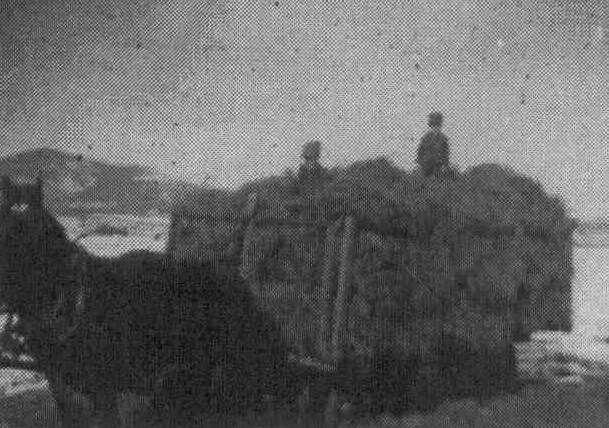Load of loose stacked hay on horse drawn wagon
One of the biggest jobs on a dairy farm is growing and hauling the hay that is needed to feed the cows during the long winter months. It is a primary focus during the summer months. Our family farm is located in a mountain valley where the weather is cooler and the growing season shorter than most, so time is always of the essence. School generally let out for the summer at the end of May. June was spent getting the garden started and doing fence repairs and other preparatory work before the haying season began. We had quite a bit of freedom to relax and play outside during June, and we usually managed to get away from home for a short vacation, but once July and August hit, harvesting the hay crop was the main focus.
When I was young, my Dad and my Grandfather were still using horse teams for much of the farm work. We had two sets of horses, Kit and Queen, and June and July. Both teams were mother and daughter. As I remember, Daddy would first mow the hay. We did have a tractor, and bought another, larger one when I was older, and in most of my memories he did use the tractor for mowing. The hay would dry in the fields for several days, (and we always prayed it would not rain. Rain meant days of delays, and if the hay was already cut and got rained on, it could spoil before it would dry sufficiently to be stored in the hay stack without molding and spoiling.) When the hay was sufficiently dry, Grandpa or one of my older siblings would rake the hay into long windrows with a horse drawn rake.
Next Daddy or Grandpa would push the rows of hay into piles just the right size for the tractor, or the horses to carry by wooden forklift to the site of the haystack that was currently being built. When I was young we stacked much of the hay loose in big haystacks out in the hay fields. The tractor would push the pile of hay onto the forklift or into the net of a derrick which would then lift the load of hay up to the top of the haystack by means of a horse-drawn pulley. Daddy would be at the top of the hay stack to distribute the hay evenly over the top of the stack with a pitch fork. Yes, it was hot, strenuous, itchy work. Long jeans and long sleeved shirts and leather gloves are necessary apparel for hauling hay. We younger folk would have the chores of leading the horse that powered the derrick on each trip or using a pitchfork to gather up any hay that dropped off the load, set it to the side, and then add it to the next load of hay before it was lifted to the top of the pile. The older siblings would be in charge of driving the tractor or using a horse for raking or pushing the hay into piles.
I wasn't too very old before Daddy bought a hay baling machine and the new tractor, and we switched from loose stacks of hay to building the stacks of baled hay. This changed the work processes quite a bit. There weren't very many jobs for a younger child with the hay bailing and hauling process. One needed to be old enough to drive a tractor or strong enough to lift a hay bale from the field onto the wagon. Somehow at this point I usually ended up inside helping my mother with the cooking or cleaning instead of outside helping with the haying. As I grew older there were usually male cousins or young men from town who were hired to help out with hauling the hay.
Daddy pushing hay into the barn with the horses, long before I came along.


Thanks for commenting on my blog! My posts are usually infrequent, but the A to Z challenge appeals to my love for the alphabet. Last year I didn't pick a theme. I just wanted to see if could do it. And I could!
ReplyDeleteI'm so glad you were able to finish last year, and that you have come back for more!
Delete